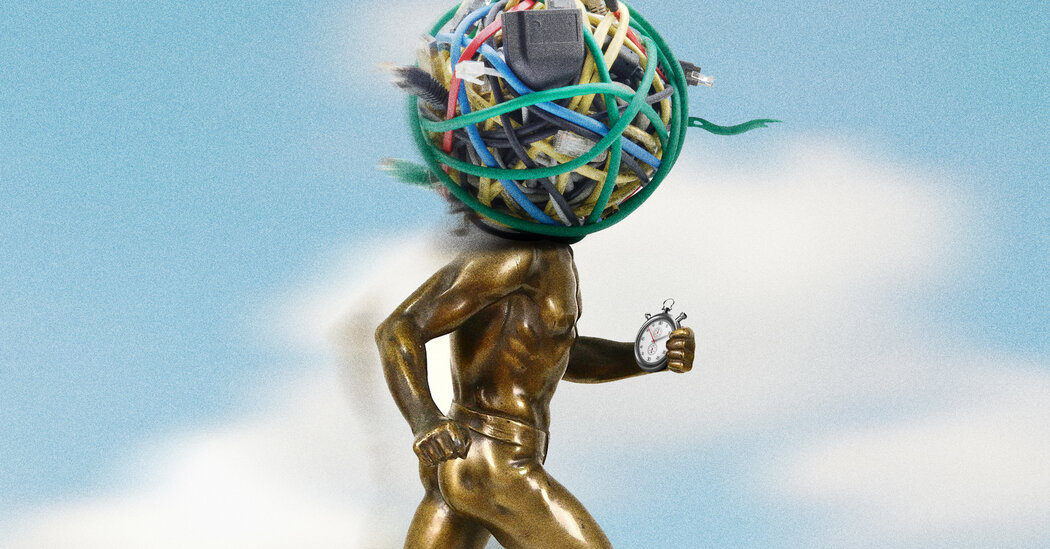Some parts of my house are neat, others are not — like the cabinet under my kitchen sink. A few months ago, when it was so stuffed that I couldn’t shut the doors, I finally decided to do something about it. That’s when I realized that the sink had sprung a leak and that all of the paper towels, boxes, bottles and rags below had congealed into a large, square-shaped loaf.
This sort of thing happens more often than you’d think, said Melissa Dilkes Pateras, an organizing expert and author of “A Dirty Guide to a Clean Home.” Still, I would have saved myself a lot of grief if I had purged when my cabinets started bulging.
Gearing up to declutter can be daunting, but small jobs can have a major effect, said Amelia Pleasant Kennedy, a decluttering expert in Detroit.
“I call them decluttering sprints,” she said, adding that they can create momentum to tackle bigger messes.
I asked experts for three projects that you can do in under 30 minutes.
Let go of mystery chargers and cords
Many of us, Pateras said, have a dusty box or bag of mystery cords, chargers, remote controls and reusable batteries. We have no idea what they’re for, but we’re afraid to throw them out.
It’s time to dump out the container, said Pateras, who is known to her 1.6 million TikTok followers as the “Laundry Lesbian.” Separate the chargers, batteries and phones into piles. “Think about all of the things in your house that have cords or chargers, and go through and try them,” she said. If nothing fits, she said, out they go. “You don’t need your Razr flip phone charger,” she said.
To drop off electronic waste, contact your city’s sanitation department or search on sites such as Call2Recycle, Earth911 or GreenCitizen. Stores like Best Buy offer electronics recycling programs.
And if someday you find that you truly need that discarded cord, Kennedy said, a replacement is usually easy to find.
Clear the clutter out of your car
Kennedy has found that even the most committed neatnik may have a different attitude when it comes to their car.
Pateras agreed: “Some people will say, ‘My car is my one place where I can just do whatever, it’s my nest space. So I’ve got wrappers all over. I’ve got bills. I’ve got my requisition for blood work.’”
To start, Kennedy said, bring a garbage bag, wet wipes, glass cleaner and a dry cloth out to the car.
Check the doors, the cup holder, the center console, the glove compartment, under the front seats, the back pockets of the car seats and the trunk. Throw away anything that’s outdated or doesn’t belong, said Kennedy, such as old paperwork or fast food toys your kids played with for two seconds. “There’s a joke in the organizing community that we keep donations in our car that you mean to drop off, and then we leave them in there for a year,” Kennedy said.
If you keep reusable shopping bags in your trunk, Pateras said, “the rule of thumb is to have as many as you use for your biggest grocery shopping trip.”
And if you haven’t used something in the past few months, and if it’s not for an emergency, Kennedy said, return it to its proper place in the house. (A first aid kit can stay in the car, Kennedy said, but out-of-season sports equipment doesn’t need to join you year-round.)
Dig out from under the kitchen sink
Shira Gill, organizing expert and author of “Minimalista,” calls this area a “shove-and-pile zone.” “Even if you’re the only one that sees it,” she said, “clear it out as a treat for yourself.”
First, Pateras said, pull out every single thing under the sink. Then wipe off the surfaces, and get rid of expired products and worn-out items like sponges and cracked rubber gloves.
Toss specialty cleaning products that you haven’t used in at least a year, like that curdled grout cleaner, Gill said. (The American Cleaning Institute provides instructions for safe disposal). Gill also puts her dishwasher pods in a container like a Mason jar, she said, “which takes up less room and looks nicer.”
Kennedy recommends getting a caddy for your cleaning products. Stock it with multipurpose cleaners, which will lighten your load, and some microfiber towels, she said.
I finally chipped out the loaf under my sink, and now that area is clear and tidy (and dry). My new motto: No shoving, no piling.
If you hate running, here’s a three-part plan to get motivated.
While running offers many benefits, such as improving the efficiency of your heart and lungs, it can be tough to get started. Erik Vance, a reluctant runner, has a recipe for learning to tolerate what he calls a “horrible form of exercise.”
Read the article: How I Tricked My Brain Into Liking Running
Should you pay for a service that analyzes your mammogram using A.I.?
Clinics around the country have begun to offer patients a new service: having their mammograms read not just by a radiologist, but also by an artificial intelligence model. Experts weigh in on whether it is efficient.
Read the article: Is That A.I. Mammogram Worth the Cost?
The Week in Well
Here are some stories you don’t want to miss:
Let’s keep the conversation going. Follow Well on Instagram, or write to us at well_newsletter@nytimes.com. And check out last week’s newsletter about mistakes couples make when discussing money.







